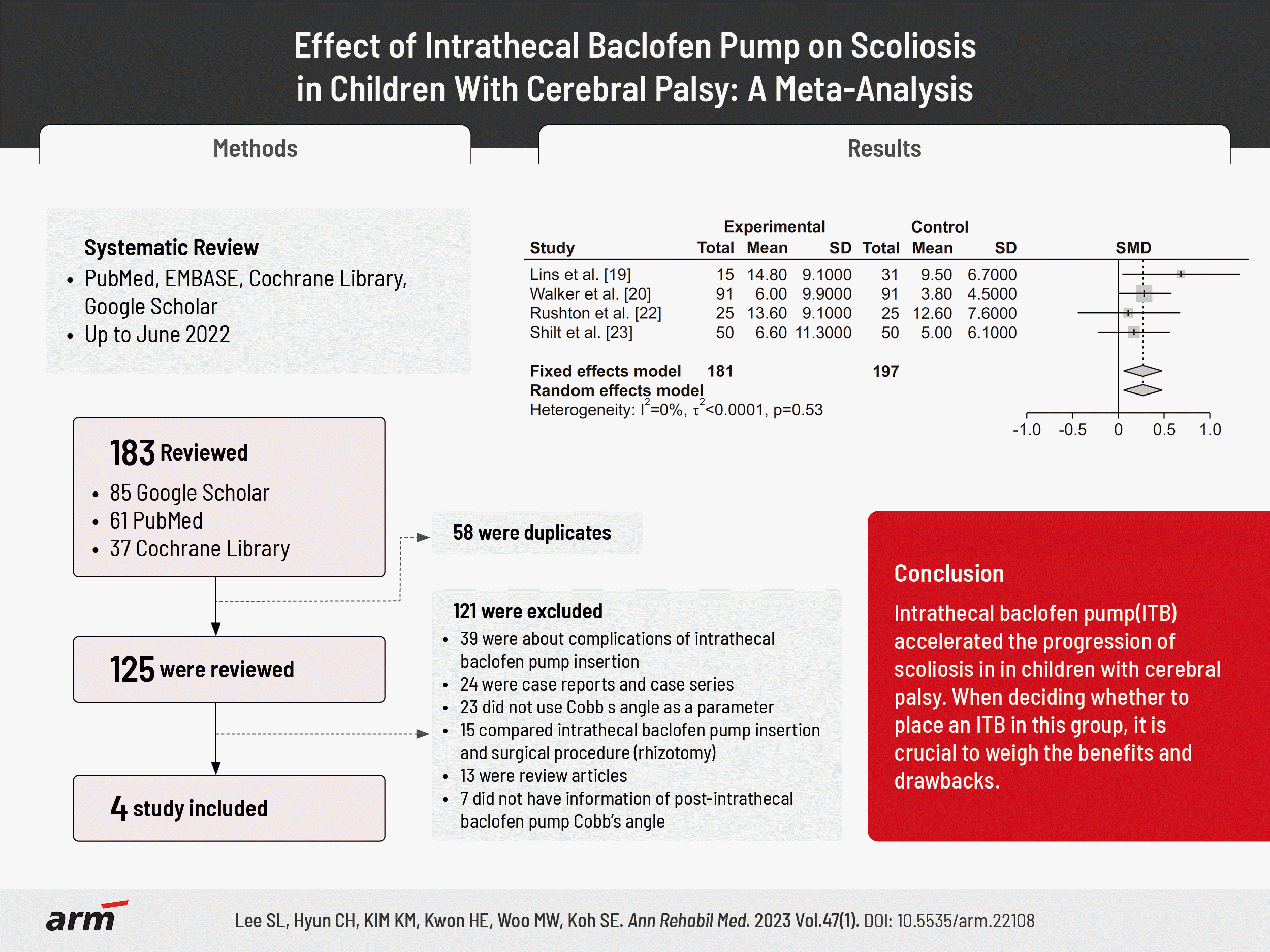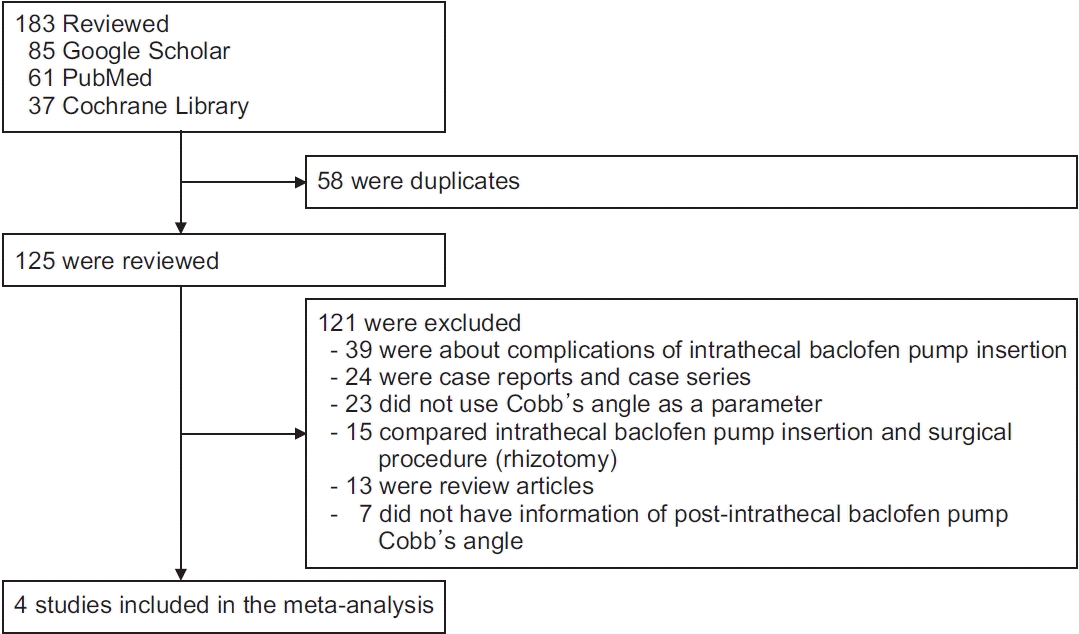1. Mutch L, Alberman E, Hagberg B, Kodama K, Perat MV. Cerebral palsy epidemiology: where are we now and where are we going? Dev Med Child Neurol. 1992; 34:547–51.
2. Sankar C, Mundkur N. Cerebral palsy-definition, classification, etiology and early diagnosis. Indian J Pediatr. 2005; 72:865–8.
3. Duman K. Cerebral palsy: an overview. Hamidiye Med J. 2022; 3:1–6.
4. Krigger KW. Cerebral palsy: an overview. Am Fam Physician. 2006; 73:91–100.
5. Krach LE. Pharmacotherapy of spasticity: oral medications and intrathecal baclofen. J Child Neurol. 2001; 16:31–6.
6. Peacock WJ, Arens LJ, Berman B. Cerebral palsy spasticity. Selective posterior rhizotomy. Pediatr Neurosci. 1987; 13:61–6.
7. Penn RD, Kroin JS. Intrathecal baclofen alleviates spinal cord spasticity. Lancet. 1984; 1:1078.
8. Ethans K. Intrathecal baclofen therapy: indications, pharmacology, surgical implant, and efficacy. Acta Neurochir Suppl. 2007; 97(Pt 1):155–62.
9. Vender JR, Hester S, Waller JL, Rekito A, Lee MR. Identification and management of intrathecal baclofen pump complications: a comparison of pediatric and adult patients. J Neurosurg. 2006; 104(1 Suppl):9–15.
10. Kudva A, Abraham ME, Gold J, Patel NA, Gendreau JL, Herschman Y, et al. Intrathecal baclofen, selective dorsal rhizotomy, and extracorporeal shockwave therapy for the treatment of spasticity in cerebral palsy: a systematic review. Neurosurg Rev. 2021; 44:3209–28.
11. Imerci A, Rogers KJ, Pargas C, Sees JP, Miller F. Identification of complications in paediatric cerebral palsy treated with intrathecal baclofen pump: a descriptive analysis of 15 years at one institution. J Child Orthop. 2019; 13:529–35.
12. Lonstein JE, Akbarnia A. Operative treatment of spinal deformities in patients with cerebral palsy or mental retardation. An analysis of one hundred and seven cases. J Bone Joint Surg Am. 1983; 65:43–55.
13. Bohn E, Goren K, Switzer L, Falck-Ytter Y, Fehlings D. Pharmacological and neurosurgical interventions for individuals with cerebral palsy and dystonia: a systematic review update and meta-analysis. Dev Med Child Neurol. 2021; 63:1038–50.
14. Davidson B, Schoen N, Sedighim S, Haldenby R, Dalziel B, Breitbart S, et al. Intrathecal baclofen versus selective dorsal rhizotomy for children with cerebral palsy who are nonambulant: a systematic review. J Neurosurg Pediatr. 2019; 25:69–77.
15. Vloeberghs M, Keetley R, Morton R. Intrathecal baclofen in the management of spasticity due to cerebral palsy. Pediatr Rehabil. 2005; 8:172–9.
16. Hasnat MJ, Rice JE. Intrathecal baclofen for treating spasticity in children with cerebral palsy. Cochrane Database Syst Rev. 2015; 2015:CD004552.
17. Sansone JM, Mann D, Noonan K, Mcleish D, Ward M, Iskandar BJ. Rapid progression of scoliosis following insertion of intrathecal baclofen pump. J Pediatr Orthop. 2006; 26:125–8.
18. Ginsburg GM, Lauder AJ. Progression of scoliosis in patients with spastic quadriplegia after the insertion of an intrathecal baclofen pump. Spine (Phila Pa 1976). 2007; 32:2745–50.
19. Lins LAB, Nechyporenko AV, Halanski MA, Hetzel SJ, Noonan KJ. Does an intrathecal baclofen pump impact scoliosis progression and complicate posterior spine fusion in patients with cerebral palsy? Spine Deform. 2020; 8:115–21.
20. Walker KR, Novotny SA, Krach LE. Does intrathecal baclofen therapy increase prevalence and/or progression of neuromuscular scoliosis? Spine Deform. 2017; 5:424–9.
21. Senaran H, Shah SA, Presedo A, Dabney KW, Glutting JW, Miller F. The risk of progression of scoliosis in cerebral palsy patients after intrathecal baclofen therapy. Spine (Phila Pa 1976). 2007; 32:2348–54.
22. Rushton PRP, Nasto LA, Aujla RK, Ammar A, Grevitt MP, Vloeberghs MH. Intrathecal baclofen pumps do not accelerate progression of scoliosis in quadriplegic spastic cerebral palsy. Eur Spine J. 2017; 26:1652–7.
23. Shilt JS, Lai LP, Cabrera MN, Frino J, Smith BP. The impact of intrathecal baclofen on the natural history of scoliosis in cerebral palsy. J Pediatr Orthop. 2008; 28:684–7.
24. Kalen V, Conklin MM, Sherman FC. Untreated scoliosis in severe cerebral palsy. J Pediatr Orthop. 1992; 12:337–40.
25. Page MJ, McKenzie JE, Bossuyt PM, Boutron I, Hoffmann TC, Mulrow CD, et al. The PRISMA 2020 statement: an updated guideline for reporting systematic reviews. BMJ. 2021; 372:n71.
26. Butler C, Campbell S. Evidence of the effects of intrathecal baclofen for spastic and dystonic cerebral palsy. AACPDM Treatment Outcomes Committee Review Panel. Dev Med Child Neurol. 2000; 42:634–45.
27. Willoughby KL, Ang SG, Thomason P, Rutz E, Shore B, Buckland AJ, et al. Epidemiology of scoliosis in cerebral palsy: a population-based study at skeletal maturity. J Paediatr Child Health. 2022; 58:295–301. Erratum in: J Paediatr Child Health 2022;58:743.
28. Hägglund G, Pettersson K, Czuba T, Persson-Bunke M, Rodby-Bousquet E. Incidence of scoliosis in cerebral palsy. Acta Orthop. 2018; 89:443–7.
29. Gu Y, Shelton JE, Ketchum JM, Cifu DX, Palmer D, Sparkman A, et al. Natural history of scoliosis in nonambulatory spastic tetraplegic cerebral palsy. PM R. 2011; 3:27–32.
30. Burn SC, Zeller R, Drake JM. Do baclofen pumps influence the development of scoliosis in children? J Neurosurg Pediatr. 2010; 5:195–9.
31. Lee BK. Influence of the proprioceptive neuromuscular facilitation exercise programs on idiopathic scoliosis patient in the early 20s in terms of curves and balancing abilities: single case study. J Exerc Rehabil. 2016; 12:567–74.
32. Willson LR, Rogers LG, Gingrich N, Shearer K, Hryniuk SS. Meeting the needs of parents of children with scoliosis: a qualitative descriptive study. Glob Qual Nurs Res. 2021; 8:23333936211045058.




 PDF
PDF Citation
Citation Print
Print







 XML Download
XML Download